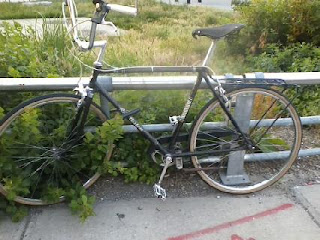A few years ago, it seemed that the "buzz" in the bike world was about "gravel bikes".
I can't say I've ever owned anything specifically designed as a "gravel bike". I have, however, ridden all sorts of bikes--some my own, others not--on gravel. Perhaps the bikes I pedaled most over pebbly surfaces were my mountain bikes and the one cyclo-cross bike (a VooDoo Wazoo) I ever owned. I've also ridden road and touring bikes on such surfaces, usually as part of some other ride I was doing: When you go on a loaded tour outside urban and suburban areas, you're bound to ride on gravel or dirt some time or another. I even rode my racing bikes, with sew-up tires, on gravel--if not for long distances.
I suspect that most, if not all, of you have ridden on gravel with a bike that wasn't designed for the purpose. And most of you were no worse for the experience than Gaynor Yancey was after running her brand-new "English Racer" into the rough stuff.
(I suspect Ms. Yancey isn't much older than I am: I referred to the three-speed bike my grandfather gave me as an "English Racer", as most people did in those days!)
She, like me, did not plan her plunge into the pebbles: She encountered the crunchy stuff in the course of her ride. But her foray didn't end so well because she wasn't as prepared as I was. As she relates, she'd never before ridden a bike with "hand brakes". So, when the paved street on which she'd ridden ended, she wasn't able to follow her mother's instructions to stop and walk her bike over the gravel path to her friend's house. She was so distracted by her vision of showing off her new bike to her friend, she says, that she "forgot about the handbrakes."
She ended up with a knee full of gravel. "And, on top of that, my beautiful new bike was hurt," she recalls.
Would things have been different if she'd gotten a "gravel bike" instead of an "English Racer" for her birthday?
I can't say I've ever owned anything specifically designed as a "gravel bike". I have, however, ridden all sorts of bikes--some my own, others not--on gravel. Perhaps the bikes I pedaled most over pebbly surfaces were my mountain bikes and the one cyclo-cross bike (a VooDoo Wazoo) I ever owned. I've also ridden road and touring bikes on such surfaces, usually as part of some other ride I was doing: When you go on a loaded tour outside urban and suburban areas, you're bound to ride on gravel or dirt some time or another. I even rode my racing bikes, with sew-up tires, on gravel--if not for long distances.
I suspect that most, if not all, of you have ridden on gravel with a bike that wasn't designed for the purpose. And most of you were no worse for the experience than Gaynor Yancey was after running her brand-new "English Racer" into the rough stuff.
(I suspect Ms. Yancey isn't much older than I am: I referred to the three-speed bike my grandfather gave me as an "English Racer", as most people did in those days!)
 |
| Just remember that you don't have a gravel bike! |
She, like me, did not plan her plunge into the pebbles: She encountered the crunchy stuff in the course of her ride. But her foray didn't end so well because she wasn't as prepared as I was. As she relates, she'd never before ridden a bike with "hand brakes". So, when the paved street on which she'd ridden ended, she wasn't able to follow her mother's instructions to stop and walk her bike over the gravel path to her friend's house. She was so distracted by her vision of showing off her new bike to her friend, she says, that she "forgot about the handbrakes."
She ended up with a knee full of gravel. "And, on top of that, my beautiful new bike was hurt," she recalls.
Would things have been different if she'd gotten a "gravel bike" instead of an "English Racer" for her birthday?

















.jpg)




.jpg)



